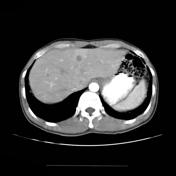Prostate sarcoma
Updates to Case Attributes
Histology
Microscopic description
Tissue shows inin areas unremarkableunremarkable surface epithelium comprisingepithelium comprising urothelium. Most ofof the tissue showsshows a malignant spindle cellcell tumour comprising fascicles of of moderately pleomorphic spindle cells with ovoid nuclei. There are frequent apoptotic bodies and mitosis are plentiful (approximately 12 per 10 high power field). There are areas of necrosis. Some of the tumour showsshows focal myxoid areas. There is no definite skeletal orskeletal or smooth muscle differentiationmuscle differentiation, nor isis there a heterologous component. There is no malignant epithelialepithelial component. TheThe tumour infiltrates into bundlesinto bundles of smooth muscle presumablysmooth muscle presumably muscularis propria (detrusor). There are also foci of lymphovascular space invasion.
The neoplastic cells show diffusediffuse strong staining withwith vimentin. They are negative forfor a panel of cytokeratin stainscytokeratin stains (AE1/3, PAN and EMA), PSA (prostate specific antigenantigen), muscle markers dermisnmarkers desmin, smooth muscle actin (SMA) and caldesmon and melanoma markersmarkers gp-100 and Mel-A. There is focal, weak equivocal staining ofof some cells with S-100, and the significance of this is uncertain.
The morphology is of a malignant sarcomatoid neoplasmneoplasm, and in view of the negative keratin staining, it is most likely a sarcoma.
The differential diagnosis (which hasn't been entirely excluded) includes a monomorphic synovial sarcomasarcoma for which cytogenetic studiesstudies to demonstrate the diagnostic translocation tt(X;18) will bebe necessary. A spindle cell rhabdomyosarcoma has been considered in the differential diagnosis but this is considered less likely as most of thesethese tumours are desmin-positive and there are morphologically identifieableidentifiable rhabdomyoblasts (which are not seen in this case).
Final diagnosis
Transurethral biopsies -FINAL DIAGNOSIS: high grade sarcoma-grade sarcoma with lymphvascularlymphvascular invasion, morphology initially suggesting a synovial sarcoma. FISH studies are NEGATIVE for SYT (18q11.2) breakapart signals however. (X;18) translocation associated with synovial sarcoma NOT detected.
In view of the negative FISH study, this tumour isis best considered a high grade-grade sarcoma, NOS.
-<p><strong>Histology</strong></p><p>Microscopic description</p><p>Tissue shows in areas unremarkable surface epithelium comprising urothelium. Most of the tissue shows a malignant spindle cell tumour comprising fascicles of moderately pleomorphic spindle cells with ovoid nuclei. There are frequent apoptotic bodies and mitosis are plentiful (approximately 12 per 10 high power field). There are areas of necrosis. Some of the tumour shows focal myxoid areas. There is no definite skeletal or smooth muscle differentiation, nor is there a heterologous component. There is no malignant epithelial component. The tumour infiltrates into bundles of smooth muscle presumably muscularis propria (detrusor). There are also foci of lymphovascular space invasion.</p><p>The neoplastic cells show diffuse strong staining with vimentin. They are negative for a panel of cytokeratin stains (AE1/3, PAN and EMA), PSA (prostate specific antigen), muscle markers dermisn, smooth muscle actin (SMA) and caldesmon and melanoma markers gp-100 and Mel-A. There is focal, weak equivocal staining of some cells with S-100, and the significance of this is uncertain.</p><p>The morphology is of a malignant sarcomatoid neoplasm, and in view of the negative keratin staining, it is most likely a sarcoma.</p><p>The differential diagnosis (which hasn't been entirely excluded) includes a monomorphic synovial sarcoma for which cytogenetic studies to demonstrate the diagnostic translocation t(X;18) will be necessary. A spindle cell rhabdomyosarcoma has been considered in the differential diagnosis but this is considered less likely as most of these tumours are desmin-positive and there are morphologically identifieable rhabdomyoblasts (which are not seen in this case).</p><p>Final diagnosis</p><p>Transurethral biopsies - high grade sarcoma with lymphvascular invasion, morphology initially suggesting a synovial sarcoma. FISH studies are NEGATIVE for SYT (18q11.2) breakapart signals however. <br>(X;18) translocation associated with synovial sarcoma NOT detected. </p><p>In view of the negative FISH study, this tumour is best considered a <strong>high grade sarcoma, NOS</strong>.</p>- +<p><strong>Histology</strong></p><p>Tissue shows in areas unremarkable surface epithelium comprising urothelium. Most of the tissue shows a malignant spindle cell tumour comprising fascicles of moderately pleomorphic spindle cells with ovoid nuclei. There are frequent apoptotic bodies and mitosis are plentiful (approximately 12 per 10 high power field). There are areas of necrosis. Some of the tumour shows focal myxoid areas. There is no definite skeletal or smooth muscle differentiation, nor is there a heterologous component. There is no malignant epithelial component. The tumour infiltrates into bundles of smooth muscle presumably muscularis propria (detrusor). There are also foci of lymphovascular space invasion.</p><p>The neoplastic cells show diffuse strong staining with vimentin. They are negative for a panel of cytokeratin stains (AE1/3, PAN and EMA), PSA (prostate specific antigen), muscle markers desmin, smooth muscle actin (SMA) and caldesmon and melanoma markers gp-100 and Mel-A. There is focal, weak equivocal staining of some cells with S-100, and the significance of this is uncertain.</p><p>The morphology is of a malignant sarcomatoid neoplasm, and in view of the negative keratin staining, it is most likely a sarcoma.</p><p>The differential diagnosis (which hasn't been entirely excluded) includes a monomorphic synovial sarcoma for which cytogenetic studies to demonstrate the diagnostic translocation t(X;18) will be necessary. A spindle cell rhabdomyosarcoma has been considered in the differential diagnosis but this is considered less likely as most of these tumours are desmin-positive and there are morphologically identifiable rhabdomyoblasts (which are not seen in this case).</p><p>FINAL DIAGNOSIS: high-grade sarcoma with lymphvascular invasion, morphology initially suggesting a synovial sarcoma. FISH studies are NEGATIVE for SYT (18q11.2) breakapart signals however<br>(X;18) translocation associated with synovial sarcoma NOT detected. </p><p>In view of the negative FISH study, this tumour is best considered a high-grade sarcoma, NOS.</p>
Updates to Study Attributes
Image CT (C+ arterial phase) ( update )

Image CT (C+ arterial phase) ( update )








 Unable to process the form. Check for errors and try again.
Unable to process the form. Check for errors and try again.